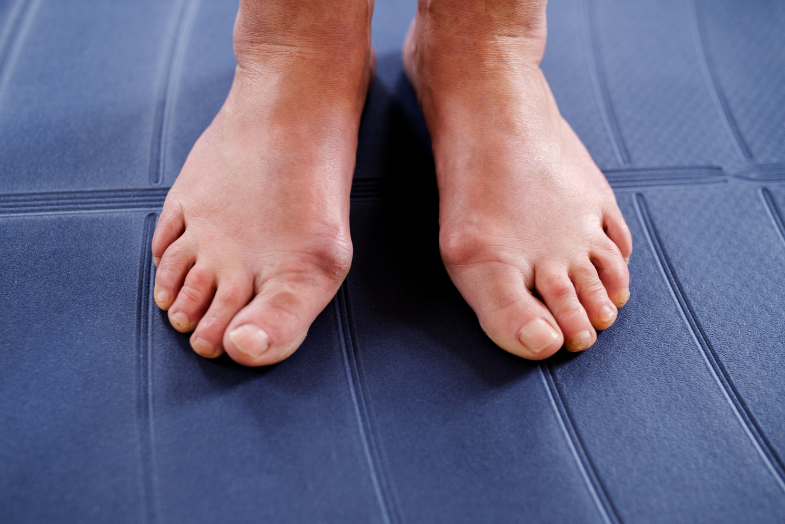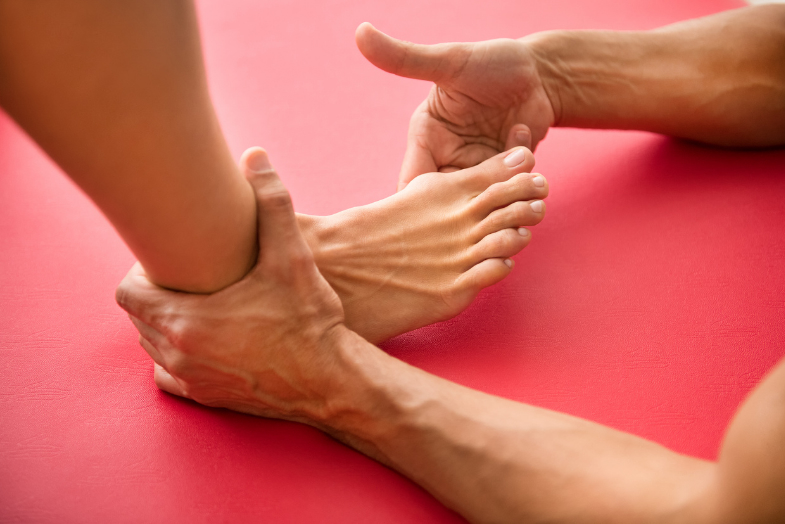What Causes Bunions?
A bunion looks like a bony bump on the side of your big toe. This might not seem like a huge deal to the average person, but bunions are caused by an abnormality of a person’s foot bones.
This abnormality forms over time–usually over a number of years. Bunions form when your big toe starts to lean in toward your other toes rather than straight ahead.
A bunion can cause your toes to uncomfortably crowd together, and eventually it can turn into a full blown deformity. Some people experience pain while others might not. Bunions tend to develop over time, so it’s important to intervene with treatment options early. Read along to learn more about what you can do about bunion pain.

What is a Bunion?
If you’ve never seen or experienced having a bunion, you might be wondering what it is and what it looks like. Essentially, a bunion is a bony bump that develops on the inside of your foot by the big toe joint.
If you have a bunion and you are experiencing pain, it’s likely due to shoe irritation. Most people who develop bunions have a family history of the deformity, which suggests that a large part of whether you will get bunions or not could be in your genetics.
Bunions are also more common in women than in men. Many things can contribute to or worsen the formation of a bunion including foot stress, arthritis, and wearing shoes that are too tight.
What to do When You Experience Bunion Pain
If you’ve noticed a small bump on your big toe that has been slowly getting worse over the years, you might have a bunion. Even if it’s not painful, a bunion will eventually develop to the point where you might need surgery to correct it.
So what should you do to help relieve bunion pain? While bunions are fairly common, that doesn’t mean they can’t interfere with your day to day life. We rely on our feet to take us everywhere. The essence of our health is tied to our ability to be mobile.
This is why it’s so important to address any concerns you have with your doctor. It’s likely that your primary care physician will recommend that you see a podiatrist to help you. A doctor’s opinion is incredibly important especially if your condition is new.
Having a doctor’s guidance can help you prevent the bunion from worsening and ease whatever pain you might have. While the exact cause of bunions is unclear, there are still many treatment options and things you can do to prevent them from getting worse.
Bunion Treatment
You might have a bunion on one or both feet. Eventually, you might find them to be rather painful, which prevents you from living life the way you want to. We understand that living in a constant state of pain can vastly reduce your quality of life, and we’re here to help.
 Luckily, there are plenty of ways to relieve bunion pain without having surgery as your first and only option. There are quite a few home remedies that you should give a try even before you have that initial doctor’s appointment.
Luckily, there are plenty of ways to relieve bunion pain without having surgery as your first and only option. There are quite a few home remedies that you should give a try even before you have that initial doctor’s appointment.
While bunions are permanent without surgery, you can still function normally and without pain by using some of these home remedies. The first thing you should try is throwing out any tight, ill fitted, or downright uncomfortable shoes!
Uncomfortable shoes can cause and worsen your bunion and the pain that comes with it. Try to only wear comfortable shoes, especially if you’re going to be walking around all day. Additionally, you want to take steps to protect the bunion from further friction.
You can get a gel or moleskin filled pad from any drugstore to help with the friction that causes bunion pain. In addition to that, you can buy shoe inserts that will help you be able to position your foot correctly.
Additionally, you should shop around for shoes that are wider in the toe area. You might even need to get shoes that are specially designed for people who suffer from bunion pain.
When to Opt for Bunion Surgery
For podiatrists, surgery is not the first solution. In fact, it’s the worst case solution for those unfortunate enough to be suffering from bunion pain for long periods of time. The first type of change podiatrists want to see from patients with bunions is what they wear on their feet.
If you make all of the right changes to your life in order to lessen the pain and suffering caused by bunions, and you are still having trouble, then your podiatrist might suggest undergoing surgery. If your pain persists for more than a year, then you might want to discuss this next step with your doctor.
Most patients will have bunion pain off and on for years before surgery is necessary. Surgery can be done in many cases, whether they’re mild or severe. The goal of surgery is to first, remove the bunion. Then, your surgeon will correct the big toe and put it in the right position.
A surgeon will move bones, tendons, ligaments, and nerves back into place once it’s all said and done. This should result in relieving your pain hopefully for good.
Where to Find Foot and Ankle Doctors
At Foot & Ankle Specialists of Illinois (FASI), we are dedicated to treating our patients with the absolute best quality care in the state. We offer a plethora of bunion care and treatment options, both surgical and non-surgical.
If you live in the Northwest suburbs and are tired of the pain and strife a bunion has been causing in your life, talk to us. Our specialists can help educate you on bunions as well as come up with a plan to treat your bunion pain.
Additionally, if you are looking to treat any other foot or ankle related conditions, take a look at our website. We treat everything from broken bones to diabetic conditions to skin and nails. Book an appointment with us today!

